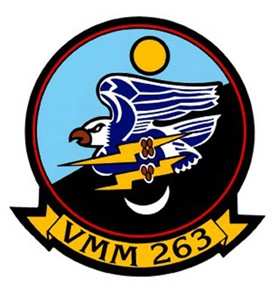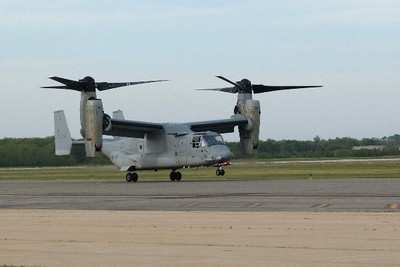Will Soon Start Seven-Month Combat Tour
The first V-22 Osprey combat squadron left for Iraq this week
onboard a Navy amphibious assault ship, marking a pronounced shift
in military aviation technology.

Marine Corps spokesman Major Eric Dent told McClatchy Newspapers
10 Ospreys left Monday aboard the USS Wasp, in a surprisingly
low-key deployment made with little fanfare... though under
extremely tight security.
"It was just another workday for the squadron," Dent said.
Citing "operational security," Dent would not discuss when the
Ospreys were due to arrive in Iraq.
Marine Medium Tiltrotor Squadron 263 -- nicknamed "The Thunder
Chickens" -- will base its MV-22s (the Marine verison of the
Osprey) at the Al Asad Airbase in western Iraq. The squadron is
scheduled to conduct at least seven months of combat
operations.
 As ANN reported, announcement
of the Pentagon's plan to deploy the Ospreys was met with criticism
earlier this year, from those who say the tiltrotor Osprey --
plagued by a series of technical problems and a string of fatal
accidents early in its development -- is still too tempermental to
reliably perform in combat situations.
As ANN reported, announcement
of the Pentagon's plan to deploy the Ospreys was met with criticism
earlier this year, from those who say the tiltrotor Osprey --
plagued by a series of technical problems and a string of fatal
accidents early in its development -- is still too tempermental to
reliably perform in combat situations.
In a January 2007 report by Washington-based think tank, the
Center for Defense Information (CDI), recommended the military
scrap the entire Osprey program, due to what it termed
"operational, aerodynamic and survivability challenges that will
prove insurmountable -- and lethal -- in combat."
The entire Osprey fleet was briefly grounded one month later,
due to a software problem. Four fatal accidents have occurred in
the tiltrotor's development, claiming the lives of 26 military
personnel and four civilians. The military grounded the program for
nearly two years following a December 2000 crash in Arizona.
Representatives with Bell Helicopter and Boeing -- which
partnered to manufacture the Osprey -- reply the aircraft, though
beset by difficulties early on, has since proven itself worthy, and
safe. In March, the entire Osprey fleet surpassed 25,000 flight
hours; The Marines announced the probable summer deployment of the
Osprey in April.
Bell-Boeing spokesman Bob Leder said workers at the company's
facilities in Texas weren't aware the Ospreys they helped assemble
were heading to Iraq, until he posted a copy of a Marine Corps
Times article on the deployment.
"There was a feeling of great excitement and at the same time we
were praying for the safety of all the Marines," he said. "It's
like 'OK, this is the real thing.'"
The Marines acknowledge issues likely remain for the Osprey, as
situations will arise in the combat environment not seen throughout
the aircraft's 20-year development and earlier test deployments.
But the Corps stood firm in its decision to deploy the
aircraft.
Supporters of the aircraft say the Osprey can "self-deploy" into
combat situations, arriving and departing the scene much more
quickly than conventional helicopters.
The "Thunder Chickens" have 28 pilots -- including two women --
who volunteered for the job, and were chosen by a Marine Corps
selection board, according to McClatchy. The squadron commander is
Lt. Col. Paul J. Rock, Jr., who has flown Ospreys since the
1990s.

A full third of the squadron's 100 members have previous combat
experience in Iraq.
 ANN's Daily Aero-Linx (04.30.25)
ANN's Daily Aero-Linx (04.30.25) ANN FAQ: Turn On Post Notifications
ANN FAQ: Turn On Post Notifications Classic Aero-TV: Agile Aeros Jeff Greason--Disruptive Aerospace Innovations
Classic Aero-TV: Agile Aeros Jeff Greason--Disruptive Aerospace Innovations Aero-News: Quote of the Day (04.30.25)
Aero-News: Quote of the Day (04.30.25) ANN's Daily Aero-Term (04.30.25): Expedite
ANN's Daily Aero-Term (04.30.25): Expedite





